Karori | |
|---|---|
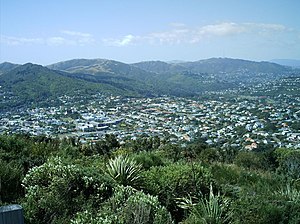 City-end Karori from Wrights Hill summit | |
|
| |
| Coordinates: 41°17′05″S 174°44′12″E / 41.284855°S 174.736795°E | |
| Country | New Zealand |
| City | Wellington City |
| Local authority | Wellington City Council |
| Electoral ward |
|
| Established | 1840 |
| Area | |
| • Land | 628 ha (1,552 acres) |
| Population (June 2023)
[2] | |
| • Total | 15,380 |
| Postcode(s) | 6012 |
| Mākara | Wilton | |
|
|
Northland | |
| Highbury, Taitville |
Karori is a suburb located at the western edge of the urban area of Wellington, New Zealand, 4 km from the city centre [3] and is one of New Zealand's most populous suburbs, [3] with a population of 15,380 in June 2023. [2]
History
Origins
The name Karori used to be Kaharore and is from te reo Māori. It comes from the Māori phrase 'te kaha o ngā rore' meaning 'the place of many bird snares'. [4] [5] [6] [7] Originally forested, Māori used the Karori area for hunting. It also had tracks crossing it that led to Māori pā on the west coast. [8]
No Māori lived in the area [9] when the first European settlers came to Karori in the 1840s, having bought the land from the New Zealand Company. The first settler in Karori, John Yule of Glasgow, [10] cleared 20 acres of forest on his section with his younger brother Moses and advertised its sale in December 1841. [11]: 9 By 1845, ten 100-acre sections were being taken up and sub-divided, and Karori recorded 215 inhabitants – 109 of them under the age of 14 years. [11]: 11
In 1845 a group of armed police from Wellington constructed a small fortified post that became known as "The Stockade" in response to fears of attacks from nearby Māori insurgents. While there were no attacks, the stockade was used for a church service and to grind grain. [11]: 15 The stockade was located on Mr Chapman's land, about halfway along what is now Marsden Avenue. [12]
The first mental hospital in Wellington was built in 1854. [10] [11]: 17 By 1871 it had 23 inmates and was run by untrained staff, which resulted in the first matron and her husband being dismissed in 1872 because of cruelty. [10] In 1873 the asylum moved from Karori to the site of present-day Government House in central Wellington. [10] Karori School took over the asylum site in 1875. [10] [11]: 23
Frederick Mackie in his book Traveller under concern described Karori in the 1850s:
- "The walk was highly romantic. The road is cut out of the sides of steep hills covered with forest. The ever-winding road, the steep declivities, the forest above and below you, and the continual murmur of streams concealed in the depths below were very pleasing, as every few yards a new scene and fresh objects were brought to view. In one spot I obtained a view of the harbour, which today was like a bright glassy lake, and beyond it were the lofty ranges of the snow-clad Rimutaka and Tararuas, partly glistening in the sun and partly shrouded in cloud." [13]
Karori gold rush
Karori experienced a gold rush when the valley of the Upper Kaiwharawhara Stream became subject to intensive gold-mining activity between 1869 and 1873. This activity eventually led to the building of the lower Karori Dam (now part of Zealandia) in 1873. [14] At the height of the rush, about 200 men worked the claims, driving shafts and drives up to 500 feet in length into the hills. [11]: 29
Growth and subdivision
In 1888 a syndicate purchased section 34, which was the closest to town (running from present day Ponsonby Road to Cooper Street). The new owners prepared the land for sale by building roads and naming them after the members of the syndicate and their families, and by running a marketing campaign, including providing free buses from Manners Street and writing poems:
In far-famed New Zealand, the evergreen free land
Most favoured and beautiful Queen of the wave,
Where the sun ever smiling, bad weather beguiling,
Brightly shines on the face of the honest and brave.
Tho' for Europe's bold races there are plenty of places
Adapted as homes for the great and the small,
Yet, for onward progressing and bountiful blessing
There is one whose position is far before all.
So haste where kind Nature's arrayed in her glory,
To pleasant, romantic, suburban Karori. [11]: 30–31
Karori Borough, 1891–1920
Karori was a part of Hutt County from the county's establishment in 1877 to 1891 when Karori was declared a separate borough following a petition in favour of forming a borough with 123 signatories. A counter-petition garnered 41 signatories. [11]: 31–32
List of mayors of Karori Borough
| # | Name | Term |
|---|---|---|
| 1 | Stephen Lancaster | 1891–1894 |
| 2 | Richard Bulkley | 1894–1901 |
| 3 | F. J. McDonald | 1901–1902 |
| 4 | E. C. Farr | 1902 |
| 5 | J. B. Tarr | 1902–1903 |
| 6 | W. H. Tisdall | 1903–1904 |
| 7 | A. C. Pearce | 1904–1908 |
| 8 | C. A. Dasent | 1908–1911 |
| 9 | C. Cathie | 1911–1914 |
| 10 | W. T. Hildreth | 1914–1915 |
| 11 | B. G. H. Burn | 1915–1920 |
Amalgamation with Wellington, 1920
Both Wellington and Karori expanded towards each other, the two urban areas becoming gradually connected, aided by the construction of the Karori tunnel in 1901, [15] and the Borough of Karori amalgamated with the City of Wellington in 1920. [16]
Demographics
Karori, comprising the statistical areas of Karori East, Karori North, Karori Park and Karori South, covers 6.28 km2 (2.42 sq mi). [1] It had an estimated population of 15,380 as of June 2023, with a population density of 2,449 people per km2.
| Year | Pop. | ±% p.a. |
|---|---|---|
| 2006 | 14,004 | — |
| 2013 | 14,679 | +0.67% |
| 2018 | 15,234 | +0.74% |
| Source: [17] | ||
Karori had a population of 15,234 at the 2018 New Zealand census, an increase of 555 people (3.8%) since the 2013 census, and an increase of 1,230 people (8.8%) since the 2006 census. There were 5,361 households, comprising 7,479 males and 7,755 females, giving a sex ratio of 0.96 males per female, with 3,114 people (20.4%) aged under 15 years, 2,937 (19.3%) aged 15 to 29, 7,272 (47.7%) aged 30 to 64, and 1,911 (12.5%) aged 65 or older.
Ethnicities were 76.0% European/ Pākehā, 5.7% Māori, 3.4% Pasifika, 19.5% Asian, and 3.9% other ethnicities. People may identify with more than one ethnicity.
The percentage of people born overseas was 35.2, compared with 27.1% nationally.
Although some people chose not to answer the census's question about religious affiliation, 52.9% had no religion, 33.9% were Christian, 0.2% had Māori religious beliefs, 2.7% were Hindu, 1.2% were Muslim, 1.7% were Buddhist and 2.5% had other religions.
Of those at least 15 years old, 6,231 (51.4%) people had a bachelor's or higher degree, and 717 (5.9%) people had no formal qualifications. 4,185 people (34.5%) earned over $70,000 compared to 17.2% nationally. The employment status of those at least 15 was that 6,549 (54.0%) people were employed full-time, 1,797 (14.8%) were part-time, and 501 (4.1%) were unemployed. [17]
| Name | Area (km2) |
Population | Density (per km2) |
Households | Median age | Median income |
|---|---|---|---|---|---|---|
| Karori Park | 2.03 | 4,566 | 2,249 | 1,659 | 36.0 years | $43,900 [18] |
| Karori North | 1.62 | 2,589 | 1,598 | 933 | 40.4 years | $49,700 [19] |
| Karori South | 1.40 | 4,518 | 3,227 | 1,539 | 37.3 years | $45,300 [20] |
| Karori East | 1.23 | 3,561 | 2,895 | 1,230 | 42.4 years | $47,900 [21] |
| New Zealand | 37.4 years | $31,800 |
Sports teams
Waterside Karori association football club founded when Karori Swifts and Waterside (a club based in Kaiwharawhara) merged.
- Karori United Tennis Club based in Karori. [22]
- Karori Amateur Athletics Club [23]
- Karori Cricket Club [24]
- Karori Netball Club [25]
- Karori Bowling Club [26]
Karori Historical Society
Karori Historical Society is one of many historical societies of Aotearoa New Zealand, membership application is open to all residents and citizens of New Zealand. The activities include publishing books about the history of Karori and there are many titles listed on their website for example Karori and its People and Karori Streets 1841–1991. The book Karori Streets was updated in 2019 and is about the European settlement of the suburb. Original authors are Will Chapman and historian Katherine (Kitty) Wood who was born in 1912. Judith Burch is the president of Karori historical society and co-author of the book, Karori and its People. [27] The other author is Jan Heynes, also the vice president of the society. Heynes has family connections in Karori from in the early 1900s through the Kirkcaldie family. [27] [28] [29]
Notable people
- Katherine Mansfield (1888–1923), novelist
- George Friend (1835–1898), parliamentary official
- Duncan Oughton: football player
- George Hudson (entomologist)
- Tom Young (trade unionist)
- Harold Beauchamp: chairman of the Bank of New Zealand, father to Katherine Mansfield
- Daisy Platts-Mills: doctor and community leader
- Colin McLeod (engineer)
- Samuel Duncan Parnell: activist
- Diana Mason (doctor)
- Bryan Waddle: sports broadcaster
- E. Mervyn Taylor: artist [30]
Facilities
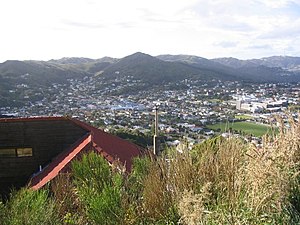
Parks and reserves
Zealandia (formerly called the Karori Wildlife Sanctuary) is an enclosed restoration project focusing on the flora and fauna that inhabited the valley before human settlement. [31]
Karori Park, on Karori Road features a football and cricket sports ground, all-weather track, changing rooms and play area. [32]
Ben Burn Park, on Campbell Street features a football and cricket sports ground, changing rooms, athletics, play area and artificial cricket surfaces. [32]
Wrights Hill Reserve in southern Karori features mountain bike and walking tracks and the historic Wrights Hill Fortress with a network of tunnels and gun emplacements overlooking the valley. [33]
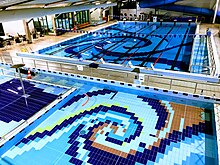
Makara Peak Mountain Bike Park in southern Karori has over 40 km of mountain bike and walking tracks built by the mountain biking community and is recognised as a world-class area dedicated to mountain biking. [34]
Karori pool
Karori pool is a modern indoor swimming complex with a 25-metre heated pool, learners' pool, toddlers' pool, spa pool and a 30-metre hydro-slide. [35] The pool was originally an outdoor facility first opened in 1936. [36] The pool was converted to an indoor pool in 2001 [37] and additional work in 2010 added the hydro-slide. [38] The pool is home to the Karori Pirates swimming club. [39]
Shopping
The centre of Karori contains a basic shopping mall with two supermarkets, a Council-operated library (containing a café), a recreation centre and other amenities.

Library
Karori Library opened in the 1840s, operating out of the community hall at the site of the present day library on Karori Road. In November 2005, the current two-level library and café were opened. [40] The architects were Warren and Mahoney and the building received critical acclaim receiving this review in Architecture New Zealand: "The Karori library is a box of light that shines brightly in an overcast suburb. The relationship to the street is a model for all those who design for the outer city." [41]
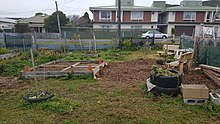
Community garden
The Karori Community Garden was founded in 2015 by Paul Stevenson. It is located at 21 Beauchamp Street, behind the Beauchamp Street Chapel. [42] [43]
Churches and cemeteries


Karori Cemetery is the second-largest in New Zealand. [15] [44] Opened in 1891, it replaced the cemetery at Bolton Street as the main burial ground for the inhabitants of Wellington. It covers 100 acres / 40 hectares. The Small Chapel contains excellent stained glass windows designed by Wilhelmina Geddes. The cemetery contains the war graves of 267 Commonwealth service personnel of World War I and 123 of World War II, in separate plots for each war, the plots being linked by the Wellington Provincial Memorial (in the form of a marble archway) which commemorates 65 World War I and 20 World War II military personnel from the Wellington Military District who died abroad and have no known grave (most were buried at sea). [45] Karori Cemetery "closed" in 1965 for the establishment of new burial plots, but interments in established graves continue.
Futuna Chapel, built in 1961 by the Society of Mary, was awarded New Zealand Institute of Architects Gold medal for best building in 1968. [46] The chapel was deconsecrated in 2000 and was sold to a property developer who planned to clear the section for residential development. [46] The building was saved when it was listed as a heritage building and is being restored by a Charitable Trust. [47]
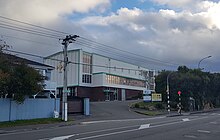
Other churches in Karori include:
- Karori Anglican Church [48]
- Karori Baptist Church [49]
- Catholic Church St Theresa [50]
- St Anselm's Union Church [51]
- St Ninian's Uniting [52]
- St Mary's Anglican Church [53]
Public transport
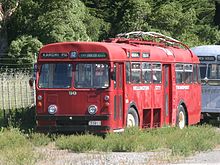
Until 31 October 2017, the full length of Karori Road was served by the Karori Park trolley bus route, which replaced the former tram service in 1954. For many years vehicles on this route ran as Route 12 to Courtenay Place, but are now designated as Route 2 and through-routed via the city - alternating between Miramar and Seatoun as destinations. The weekday seven-minute service is the most-frequent of all Wellington routes. Other routes serving the suburb are Route 18e which runs through Kelburn to Miramar via Massey University; Route 21 which runs up Beauchamp St and down Birdwood St, to and from Courtenay Place; peak-time Route 37 which runs the 21 route to The Terrace, then via Bowen St and Featherston St to Brandon St; peak-time Route 33 from Karori South to and from Brandon St and peak-time Route 34 which runs from Karori West to and from Brandon St - with an hourly service from Karori South just to and from Karori Mall during the day.
Electric buses were introduced on Route 2 in August 2021.
Education
School enrolment zone
Karori is within the enrolment zones for Wellington College, Wellington Girls' College, Wellington High School,Samuel Marsden, Karori West Normal School, and Karori Normal School. [54]
Wellington Teachers' Training College
Stage one of purpose built faculties to hold the Wellington Teachers' Training College were complete in 1969 on the site 26-40 Donald Street. It has a rich history with many notable New Zealanders attended and teaching there. Other names include the Wellington College of Education. This campus was the home of Victoria University of Wellington Faculty of Education briefly with some controversy until 2016 when the Faculty moved to the Kelburn campus. [55] [56] Construction of a retirement village on the site is underway in 2020 with the company Ryman purchasing the site in 2017. [57]
Secondary school
Samuel Marsden Collegiate School is a composite private Anglican girls' school on Karori Road in Marsden Village. It offers classes from new entrants to Year 13. In 2014 it had a roll of 502. [58]
Public primary schools
Karori Normal School is a co-educational state primary school for Year 1 to 8 students, [59] with a roll of 620 as of February 2024. [60]
It was founded in 1857 and is the second-largest full primary school in New Zealand. It has an artificial turf, two playgrounds, 35 classrooms in approximately four buildings, a concrete field, and a grass field. [61] The author Katherine Mansfield attended the school from 1895 to 1898 and there is a memorial to her at the school on a concrete field called the Katherine Mansfield field, located in front of a tree she wrote about in one of her stories. [62]
Karori West Normal School is a co-educational state primary school for Year 1 to 8 students, [63] [64] with a roll of 450. [65]
Christian schools
Samuel Marsden Collegiate School Karori is an Anglican girls' school for Year 1 to 13 students, [66] founded in 1878. [67] It has a roll of 350 as of February 2024. [68]
St Teresa's School is a co-educational state-integrated Catholic school for Year 1 to 8 students, [69] [70] with a roll of 114 as of February 2024. [71]
Preschools
There are a number of preschool education providers in Karori, including:
- Karori Playcentre
- Marsden Preschool
- Karori Kindercare [72]
- Donald Street Preschool [73]
- Karori Kids Preschool [74]
- Karori Childcare Centre [75]
- Karori Plunket Creche
- St Mary's Early Childhood Education Centre [76]
- Sunshine Kindergarten
- Kiwi Kids Preschool

References
![]() Media related to
Karori at Wikimedia Commons
Media related to
Karori at Wikimedia Commons
- ^ a b "ArcGIS Web Application". statsnz.maps.arcgis.com. Retrieved 24 June 2021.
- ^ a b "Population estimate tables - NZ.Stat". Statistics New Zealand. Retrieved 25 October 2023.
- ^ a b Jago, Francesca (16 December 2014). "Let's live in... Karori". Stuff. Retrieved 15 March 2015.
- ^ Maclean, Chris. "Story: Wellington places – Page 4 – Western suburbs". Te Ara – The Encyclopedia of New Zealand. Retrieved 15 March 2015.
- ^ "Karori name under the spotlight". Independent Herald. 20 August 2020.
- ^ "Karori". Tiki Towns. Episode Ep3. 0:40 minutes in. Nickelodeon | SKY TV. Sky TV.
- ^ Neilson, Michael (6 September 2020). "Te Wiki o Te Reo Māori: New Zealand's most mispronounced places and what to do about it". NZ Herald. Retrieved 5 August 2021.
- ^ Karori Local History, Wellington City Library, retrieved 20 February 2020
- ^ Brodie, J (1973). "The Stockade Vol. 1 No. 1". Karori Historical Society. p. 3. Retrieved 15 March 2015.
- ^ a b c d e Dekker, Diana (30 July 2011). "Conquering Karori". The Dominion Post. Retrieved 17 March 2015.
- ^ a b c d e f g h Patrick, Margaret (1990). From Bush to Suburb, Karori 1840–1980. The Karori Historical Society (Inc).
- ^ Karori Stockade, retrieved 25 July 2017
- ^ Mackie, Frederick (1973). Traveller under concern: the Quaker journals of Frederick Mackie on his tour of the Australasian colonies, 1852–1855. University of Tasmania. p. 119. ISBN 0859010074.
- ^ Brodie, James (1997). The Karori Gold Rush 1869–1873. The Karori Historical Society (Inc). ISBN 0-473-04773-X.
- ^ a b Rutherford, Rebecca (19 July 2013). "Early access to the Western hills". The Wellingtonian. Retrieved 15 March 2015.
- ^ "Karori". Wellington Local History. Wellington City Libraries. Retrieved 11 November 2010.
- ^ a b "Statistical area 1 dataset for 2018 Census". Statistics New Zealand. March 2020. Karori Park (249400), Karori North (249900), Karori South (250400) and Karori East (250600).
- ^ 2018 Census place summary: Karori Park
- ^ 2018 Census place summary: Karori North
- ^ 2018 Census place summary: Karori South
- ^ 2018 Census place summary: Karori East
- ^ "Karori United Tennis Club". Retrieved 1 October 2018.
-
^
"Karori Amateur Athletics Club". Karori Amateur Athletics Club. SportsTG. Retrieved 1 October 2018.
Welcome to Karori Athletics – over 100 years of athletics in Karori
- ^ "Karori Cricket Club". Karori Cricket Club. Karori Cricket Club. Retrieved 1 October 2018.
- ^ "Karori Netball Club". Karori Netball Club. SportsTG. Retrieved 1 October 2018.
- ^ "Karori Bowling Club". Karori Bowling Club. Sporty. Retrieved 1 October 2018.
- ^ a b "Karori Historical Society". Karori Historical Society. 2021. Archived from the original on 8 February 2021. Retrieved 15 May 2021.
- ^ Thomson, Rebecca (1 March 2012). "Signing up to history". Stuff. Retrieved 29 April 2020.
- ^ "Interview with Kitty Wood". National Library of New Zealand. 12 December 1997. Retrieved 29 April 2020.
- ^ "Mervyn Taylor". New Zealand Geographic. Retrieved 25 August 2020.
- ^ "Zealandia". Retrieved 15 March 2015.
- ^ a b "Sportsgrounds Locations". Wellington City Council. Retrieved 15 March 2015.
- ^ "Wrights Hill". Wellington City Council. Retrieved 15 March 2015.
- ^ "Makara Peak Mountain Bike Park". Wellington City Council. Retrieved 15 March 2015.
- ^ "Karori Pool". Wellington City Council. Retrieved 5 October 2015.
- ^ Thomson, Rebecca (2 October 2015). "Mayor takes a dive into Karori's new pool – 150 Years of News". Stuff. Retrieved 5 October 2015.
- ^ "Karori Heritage". Wellington City Libraries. Retrieved 5 October 2015.
- ^ Revington, Ann (18 March 2010). "Karori hydroslides into Capital's aquatic history". Newswire. Retrieved 5 October 2015.
- ^ "Karori Pirates". Retrieved 5 October 2015.
- ^ "About Karori Library". Wellington City Libraries. Retrieved 15 March 2015.
- ^ "NZPlaces". nzplaces.nz. Retrieved 12 April 2020.
- ^ "Karori Community Garden – CommunityFinder". www.communityfinder.org.nz. Retrieved 29 November 2017.
- ^ "Contact information for Wellington's community gardens". Wellington City Council. Retrieved 12 April 2020.
- ^ "About Karori Cemetery". Wellington City Council. Retrieved 30 April 2020.
- ^ "Wellington Provincial Memorial". Commonwealth War Graves Commission. Retrieved 15 March 2015.
- ^ a b "Futuna Chapel Special" (PDF). Retrieved 17 March 2015.
- ^ "Karori's hidden treasure". The Dominion Post. 12 March 2011. Retrieved 17 March 2015.
- ^ "Karori Anglican Church". Retrieved 17 March 2015.
- ^ "Karori Baptist Church". Retrieved 17 March 2015.
- ^ "Catholic Church St Theresa". Retrieved 17 March 2015.
- ^ "St Anselms Union Church". Retrieved 17 March 2015.
- ^ "St Ninians Uniting". Retrieved 17 March 2015.
- ^ "St Mary's Anglican Church". Retrieved 17 March 2015.
- ^ "eLearning Schools Search". Ministry of Education.
- ^ Astwood, Karen; Dangerfield, Alison (27 April 2018). "Search the List | Wellington Teachers' Training College (Former) | Heritage New Zealand". Heritage New Zealand Pouhere Taonga. Natasha Naus, Annwyn Tobin and Blyss Wagstaff. Retrieved 29 April 2020.
- ^ "Council 'uninformed' over teachers college sale, says Uni". RNZ. 18 March 2017. Retrieved 30 April 2020.
- ^ Williams, Katarina (14 March 2019). "Karori retirement village design changes are 'more or less' as intended, Ryman Healthcare insists". Stuff. Retrieved 29 April 2020.
- ^ "Student Rolls by School 2010–2014". Ministry of Education New Zealand. Archived from the original on 15 January 2015. Retrieved 14 March 2015.
- ^ "Karori Normal School Education Review Office Report". ero.govt.nz. Education Review Office.
- ^ "Karori Normal School Ministry of Education School Profile". educationcounts.govt.nz. Ministry of Education.
- ^ "Karori Normal School Official School Website". kns.school.nz.
- ^ "Katherine Mansfield's Timeline". Katherine Mansfield Society. Retrieved 15 March 2015.
- ^ "Karori West Normal School Official School Website". kwns.school.nz.
- ^ "Karori West Normal School Education Review Office Report". ero.govt.nz. Education Review Office.
- ^ "Karori West Normal School Ministry of Education School Profile". educationcounts.govt.nz. Ministry of Education.
- ^ "Samuel Marsden Collegiate School Education Review Office Report". ero.govt.nz. Education Review Office.
- ^ "Samuel Marsden Collegiate School Official School Website". marsden.school.nz.
- ^ "Samuel Marsden Collegiate School Ministry of Education School Profile". educationcounts.govt.nz. Ministry of Education.
- ^ "St Teresa's School Official School Website". stteresas.ac.nz.
- ^ "St Teresa's School Education Review Office Report". ero.govt.nz. Education Review Office.
- ^ "St Teresa's School Ministry of Education School Profile". educationcounts.govt.nz. Ministry of Education.
- ^ "Karori Kindercare". Retrieved 15 March 2015.
- ^ "Donald Street Preschool". Retrieved 15 March 2015.
- ^ "Karori Kids Preschool". Retrieved 15 March 2015.
- ^ "Karori Childcare Centre". Retrieved 15 March 2015.
- ^ "St Mary's Early Childhood Education Centre". Retrieved 15 March 2015.